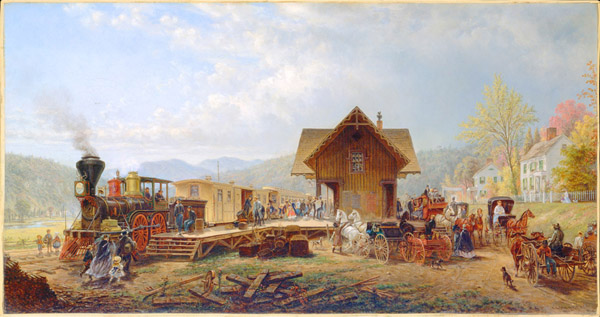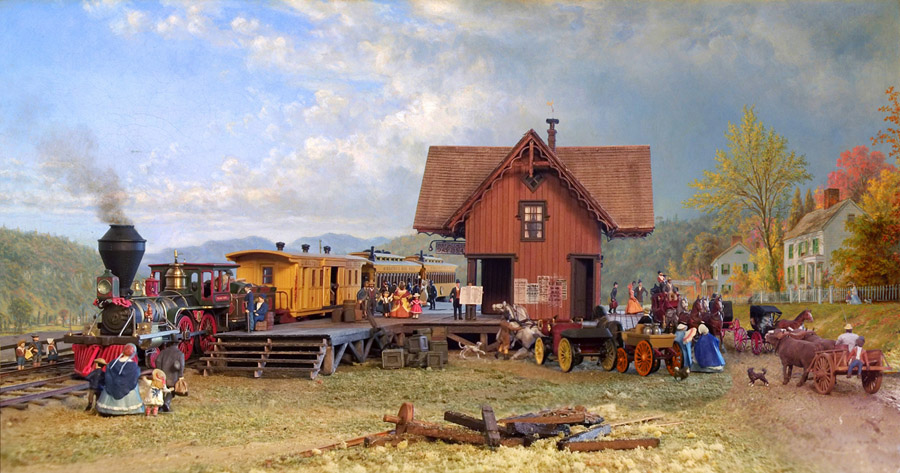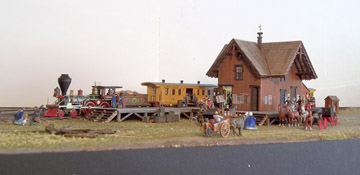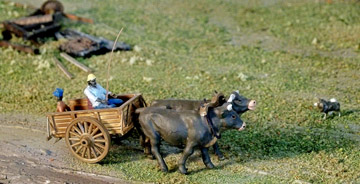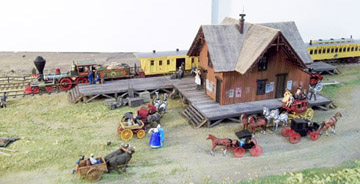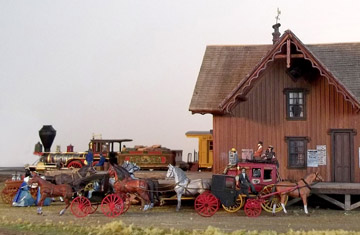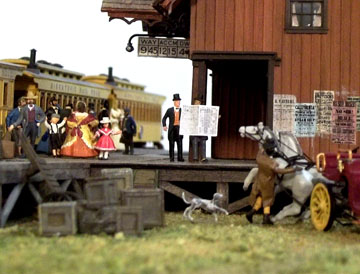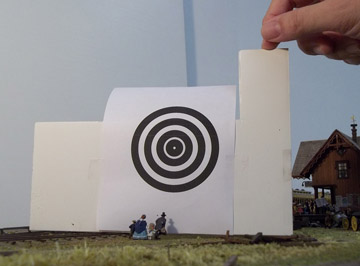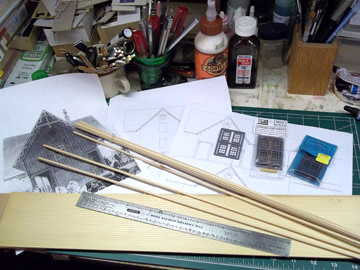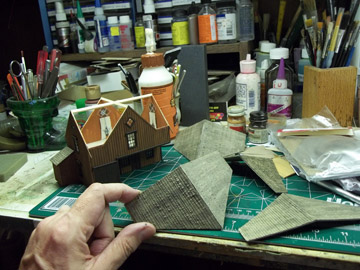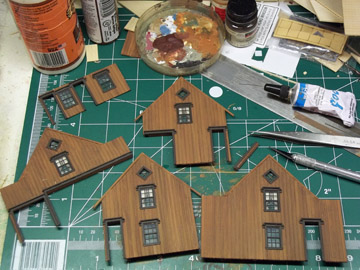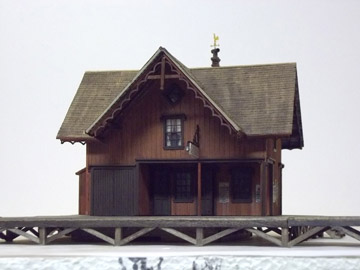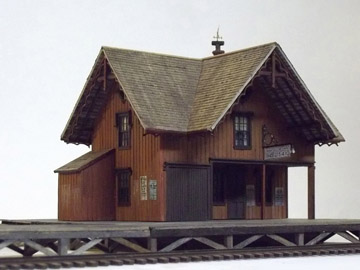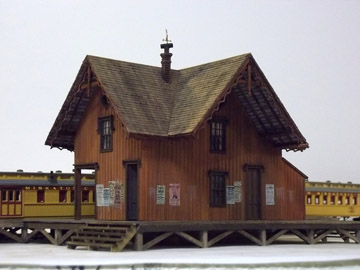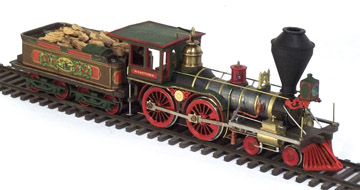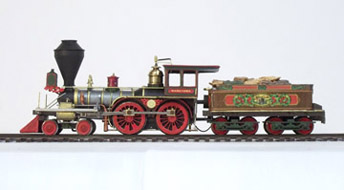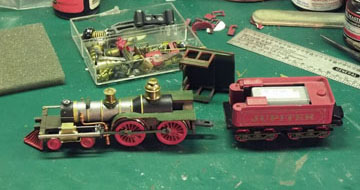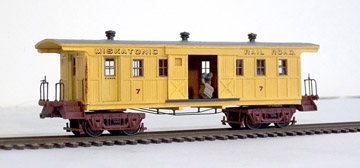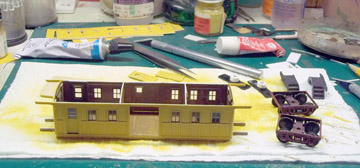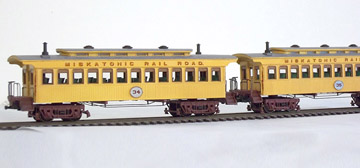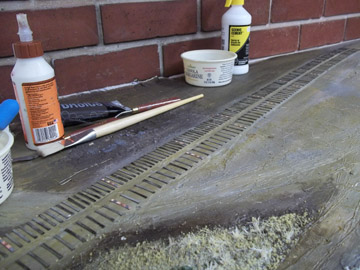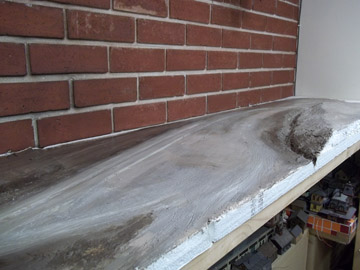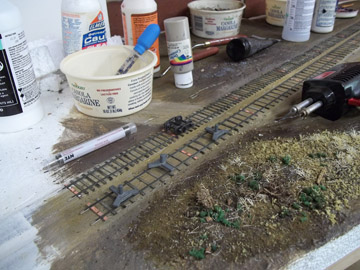In 1867, the American artist Edward Lamson Henry made this famous oil painting...
Hangs in New
York's Met.
Can't afford a decent copy...
So...
Decided to make my own.
In HO.

Click for larger images
This was a good modeling challenge. Lots of things to scratchbuild, including the station, the engine, and the cars. Had to find horses and buggies. Had to find figures that matched and paint them properly. Had to lay track and scenic some ground. Then, had to set everything up so that it photographed right.
I set it all up in an "under construction" portion of my layout— the future site of the village of Maryshead. White foam-core boards served as my photo backdrop. The background painting was Photoshopped in later.
E.L. Henry was known for his accuracy and detail in painting his subjects— but his depictions of darker-skinned Americans followed the strict stereotypes that were considered appropriate during his time. That includes the governess with the two children at right and the swallow-tail-coated coachman trying to calm the rearing horses at left.
Arranging all the figures and vehicles so that they appeared in the camera exactly where they were supposed to took about three weeks of nudging and repositioning, plus about 400 digital photos. In the end, my cheap digital camera couldn't stop down far enough to bring everything into focus. The depth of field was just too great. At this point, I almost set the scene aside until I could afford a better camera.
Eventually, I decided to "cheat" a bit and Photoshop the scene together. I made the target seen above and placed it at different distances. My cheap auto-focus camera would home in on the target. I set the camera for two-second delay, tripped the shutter, and then whipped away the target. In this way, I got pictures of all the components in focus. Just had to combine them all in Photoshop.
The scene required 50 figures, mostly Preiser, Merten, and Stadden, plus a Preiser open coach and buggy, two Jordan buggies, a Jordan stagecoach, 9 horses, 3 dogs— and an oxcart. Nobody makes an HO oxcart, so that got added to the "scratchbuild" list.
The Station...
E.L. Henry's station was patterned after the one in Stratford, CT, but he added a second story to make it a bigger building for his painting. It was a simple cross-gabled structure that I decided was best modeled with basswood, plus Tichy windows. I knew what one side looked like. Made up the rest.
Made some drawings, copied them, and cut them out to use as templates. The walls were built from 1/16" basswood board-and-batt siding framed inside with 1/8" strip stock. I aged the walls with india ink and alcohol, then brush-painted them with some ModelMaster and plain old artists' acrylics.
After the sides went together, the cross-gables were braced with more 1/8" stock. The roof was cut from Strathmore board, given some exposed rafters, and covered with Campbell shingles.
The trim on the eaves was made with another paper template spray-glued to thin cardstock and cut out with curved-bladed manicuring scissors. The chimney was a leftover from a SS Ltd. kit, likewise the weather vane.
The plaftform is more basswood— this time, I left the india-ink-stained wood unpainted. Curtains in the second-story window show that the station agent lives there. In my mind, this a perfect, rustic, small-town station from the Civil War era.
I went on the internet and downloaded some Civil War-era posters and advertisements. Halftone color printing didn't exist back then, so normal old-time color posters were right out. All the posters are black ink on colored paper stock.
The Rolling Stock...
The little Danforth engine was made with a Mantua General chassis— plus a new 3D-printed boiler, smokebox door, bell, and stack from Gerry Dykstra's Shapeways shop. The partial belt rail was brass right-angle stock. The remotored tender and cab came from an old Bachmann 4-4-0.
New pilot and tender wheels came from Northwest Short Line. With a few alterations, I used the original Mantua domes and cylinders. The Danforth builder's plate was an etching by Al Mueller. A few more Precision Scale and Cal-Scale brass castings finished the loco.
In keeping with the theme of my Miskatonic Railroad, I named the little engine Manetowa, after a native American mythical monster, and painted it to resemble the Danforth engine in the painting.
The baggage car was a typical one for Civil War times— windows, outside sliding doors and all. I built the shell from Evergreen styrene siding and strips, adding Grandt Line windows and Bachmann passenger trucks with metal wheels.
Only one side has open doors... if i want to run a train with closed doors, I just flip it around. The vents were costume jewelry odds and ends I picked up at the craft store. Printed the decals on my laser printer.
The coaches are modified Bachmanns. I took a Dremel cutoff wheel to the clerestories to get the monitor roofs. Patched the ends with more Evergreen styrene. Costume jewelry odds made up the vents and stacks.
The Scene...
...sat on sheets of 1-1/2" insulation foam, textured with Sculptamold and wallboard paste. The track roadbed was from Woodland Scenics with the edges built up. Acrylic paints provided the color.
The track had to reflect the practices of the mid-1800s: no ballast and wide tie spacing. The main line is far track. Notice that every so often I glued down a pre-tinned PC-board tie that had an electrical gap cut in the middle.
Instead of spiking, I soldered the code 55 rail to the PC-board ties. The tie stock comes in strips from Clover House. Both rails and ties were painted. In the foreground is a test patch of ground cover.
And that's the big picture. Thanks for hanging around...

